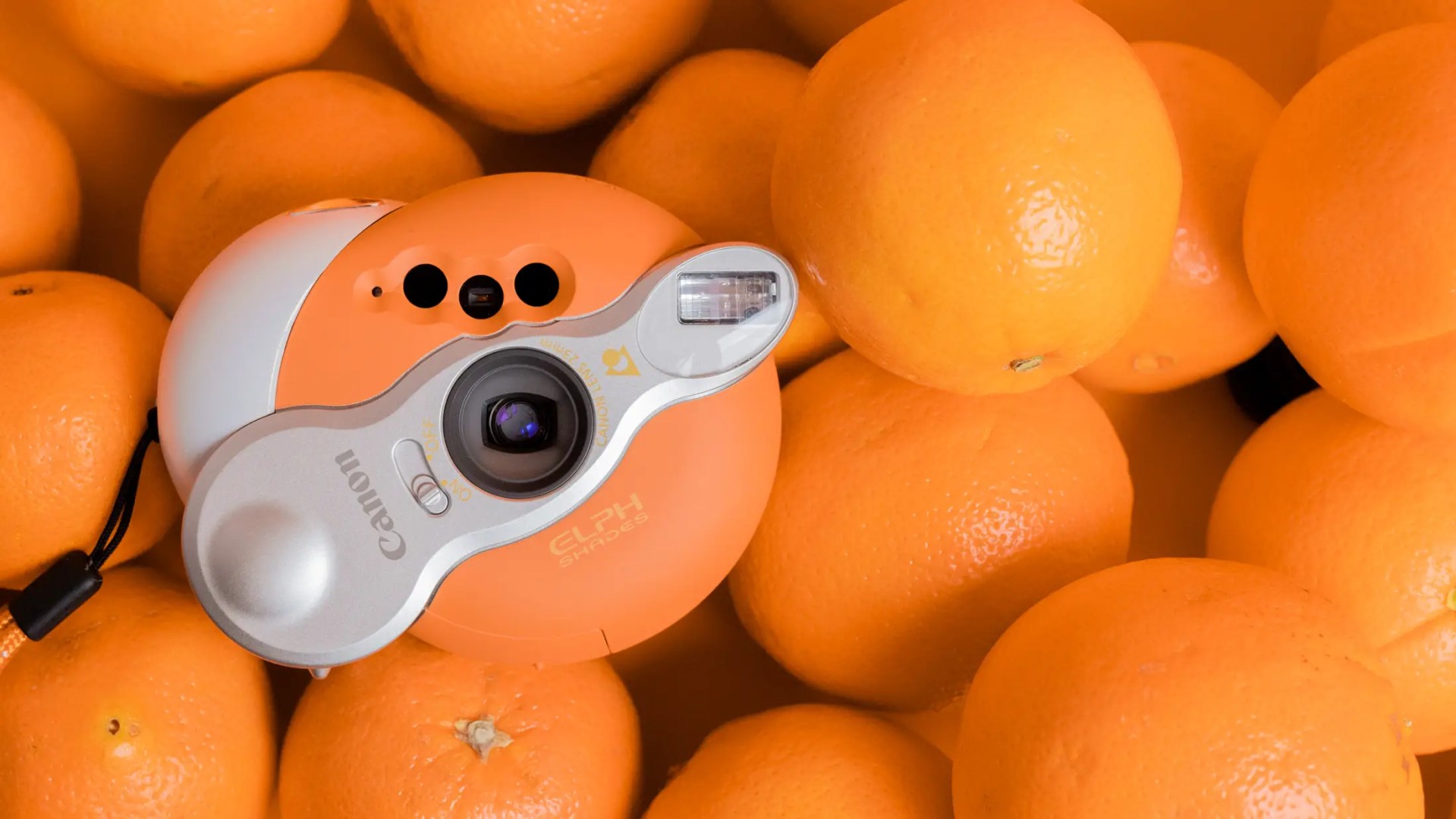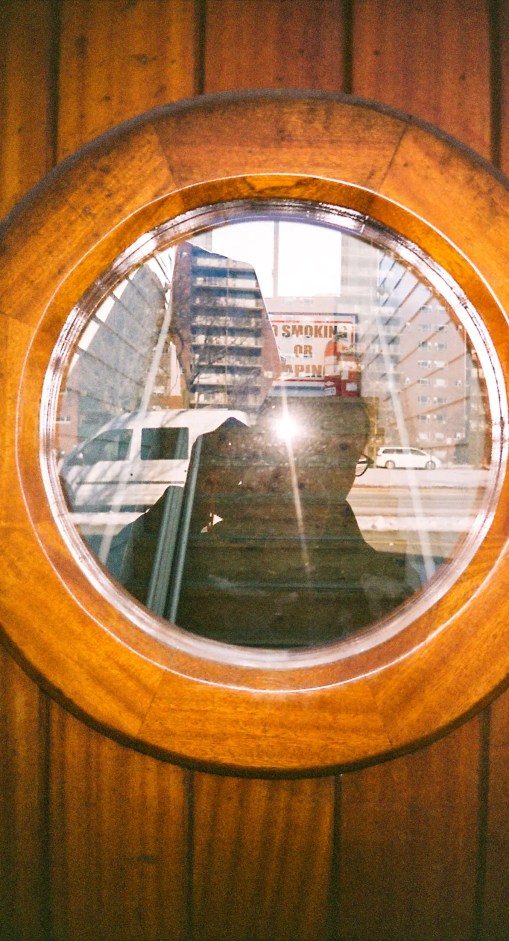Four years ago, when I published my review of the Konica Tomato point-and-shoot 35mm film camera, I expected that I was finished with writing about fruit-themed cameras. But I’d forgotten about the Canon ELPH Shades Sunshine. Released in 2002 and more appropriately named the Arancia in Europe (unreleased in Japan), the Canon ELPH Shades Sunshine is a camera whose key feature is that it looks like an orange.
I spent a week shooting a roll of film through this cute, little APS film point-and-shoot. It made pictures, which was neat. I held it, and it felt a certain way. I used its sparse features, some of which were interesting. And in the context of a review, such as the one that I’m writing and that you are now reading, I should probably touch upon all of that.
But let’s be real. We’re here for just one reason. The camera looks like an orange.
[Some of the links in this article will direct users to our affiliates at B&H Photo, Amazon, and eBay. By purchasing anything using these links, Casual Photophile may receive a small commission at no additional charge to you. This helps Casual Photophile produce the content we produce. Many thanks for your support.]
A Brief History of APS Film
APS film (an acronym for “Advanced Photo System”) is a dead film format that was first produced in 1996 and discontinued in 2011 when Kodak and FujiFilm, the format’s last two manufacturers, ceased production. It was sold under a number of brand names; Kodak Advantix, FujiFilm Nexia, Agfa Futura, and Konica Centuria.
The core idea behind APS film was an intention to simplify photography for newcomers and amateurs, to create a smaller, easier film format than 35mm film. APS film came from the factories pre-loaded into sealed canisters, which could be more easily dropped into any APS film camera than could 35mm film be loaded into a 35mm camera. All APS cameras would then handle the “complicated” operation of spooling the film through the camera for use, and reloading it into the canister after exposure, and APS film cameras were significantly smaller than comparable 35mm film cameras. In size and ease of use, at least, APS film was a success.
But APS film’s image area was significantly smaller that of 35mm film, offering just 58% of the surface area of a 35mm film. This smaller image area had an unfortunate (if predictable) side effect; compared to images made on 35mm film, APS film’s image quality was poorer. The drop in quality would be especially egregious when APS film images were printed or enlarged.
While sales of APS cameras and film were initially strong, within five years the numbers dropped significantly. Serious photographers never liked APS film because of its inferior image quality, and the format’s target demographic, amateur photographers, rapidly eschewed film en masse in favor of digital cameras.
Today, no one makes APS film, and any rolls we find will be long-expired relics of a forgotten time. Shooting expired film is fraught with peril, as described here, and here, and here. And yet my darling clementine Canon begged to be used, so I loaded a roll and crossed my fingers.
Specifications of the Canon ELPH Shades Sunshine
- Camera Type: APS format point-and-shoot film camera
- Lens: 23mm f/4.8 (3 elements in 3 groups glass Triplet design); 23mm is equivalent to 29mm in 35mm full frame format
- Focus: Automatic focus from 2 ft to infinity (3.3 ft to infinity when flash is OFF)
- Exposure: Automatic
- Flash: Built in flash; modes incl. ON, OFF, Slow Synchro, Red-Eye Reduction
- Additional Features: Drop-in film loading; Automatic film advance and rewind; Three framing modes (Classic, Wide Angle, and Panoramic; Date, Time, and Title printing functions; Magnetic Information Exchange (IX); Self-Timer; Strap
Embracing the Gimmick
The Canon ELPH Shades Sunshine is a gimmicky camera that comes from a line of unapologetically gimmicky cameras. By their very nature, APS was a pandering format. It promised to sufficiently dumb down photography to a point that any dolt could succeed. That’s a gimmick.
The cameras were small, so Canon named them “ELPH.” Not “Elf” with an F, but rather a PH. That’s also a gimmick.
And then someone in a board room asked “What if we made cameras cute?” And a product designer, hours later, munching an orange to fight the flu, doodled an orange with a lens in the middle (possibly). Another gimmick.
The result is a camera that’s as fun to look at as it is to shoot. Actually, it might be more fun to look at.
From the moment I first laid eyes on the Canon ELPH Shades Sunshine, I was ready to drink the juice. Its packaging is reminiscent of a box of orange juice. It’s strap is a friendship bracelet of sunshine. It’s plastic shell is a delightfully textured matte rind which begs to be palmed.
Using the Canon ELPH Shades Sunshine
Like most APS film point-and-shoot cameras, the ELPH Shades Sunshine is tiny, lightweight, and simple to use. True to form, one only needs to point and shoot.
The protruding handgrip fits well in the hands, and the camera balances nicely in one-handed operation. The shutter release button is large and positioned readily so that a half-press focuses and a full-press fires. The viewfinder is clean and bright, though admittedly quite small. The camera’s buttons and levers are easily identifiable, and relatively simple to press (though the top mounted SELECT and SET buttons are tiny, the strap has a little tool attached to it for pressing these).
There’s an ON/OFF slider on the front of the camera which also serves as a lens cover. Slide it to ON, peer through the camera’s viewfinder, and press the button. Easy stuff.
The flash is powerful and bright, giving indoor portraits the early 2000s blown-out, ultra-white aesthetic for which Gen Z is currently experiencing vicarious nostalgia. Turning it off or cycling through the other few various flash modes is a matter of a button press, or two or three.
There’s a top-mounted liquid crystal display which is protected by a nicely convex shield of plastic. This screen shows pertinent information, such as how many exposures we’ve made on the roll of film, battery life, our TITLE mode and DATE information, and more. It’s a neat addition, though somewhat irrelevant, given the nature of APS point-and-shoot cameras. Typically, we just don’t really care about this stuff. We’re just going to literally point and shoot.
Remember? We’re morons.
There is no tripod socket. But that’s not really a problem. APS film users don’t own tripods.
The Canon Elph Shades Sunshine has the ability to print “titles” on the back of a print. By pressing the TITLE button on the back of the camera, we can choose one of six languages and one of five messages in each language; messages like “I Love You,” and “Thank You,” and “Happy Birthday.” How cute, though not of much use for those of us uninterested in printing low-quality APS film images (me).
[Some of the links in this article will direct users to our affiliates at B&H Photo, Amazon, and eBay. By purchasing anything using these links, Casual Photophile may receive a small commission at no additional charge to you. This helps Casual Photophile produce the content we produce. Many thanks for your support.]

Image quality
There are two important things to remember when discussing image quality of APS film cameras.
First, in terms of image quality, APS film was always inferior to 35mm film.
Second, any APS film we find today will invariably be expired, which means that image quality is worse than ever.
Considerations considered, the Canon ELPH Shades Sunshine made decent photos in my week of testing. The expired film was indeed lower in contrast than it would have been when new, and some color shifts did present. However, sharpness and clarity from the little 23mm lens were fairly good when images were made in bright light or with the camera’s built-in flash.
There’s fairly significant ghosting, flaring, and distortion, as well as noticeably vignetting in my sample images.
The Canon ELPH Shades Sunshine is certainly not a good choice for times when image quality is important. But, hey, in times when a camera simply must look like an orange, there’s no better machine.
Final Thoughts
I suppose I could end on a metaphor.
If a camera is a fruit, then the photos are the juice. If that’s true, the ELPH Shades Sunshine is a bit spoiled. While not totally rotten or ready for the compost heap, it’s certainly past the sell-by date.
But I don’t think a camera like this needs to make great images. Or, to be honest, any images at all. It’s a gimmicky camera, a design exercise, a product to tickle the edge of our lips and remind us that, no, not all things have to be serious.
The Canon ELPH Shades Sunshine looks great sitting on a shelf in my office. It’s cheap and cute. I like its gimmick, and sometimes that’s enough.


Follow Casual Photophile on Youtube, Twitter, Facebook and Instagram
[Some of the links in this article will direct users to our affiliates at B&H Photo, Amazon, and eBay. By purchasing anything using these links, Casual Photophile may receive a small commission at no additional charge to you. This helps Casual Photophile produce the content we produce. Many thanks for your support.]




















Peachy keen!